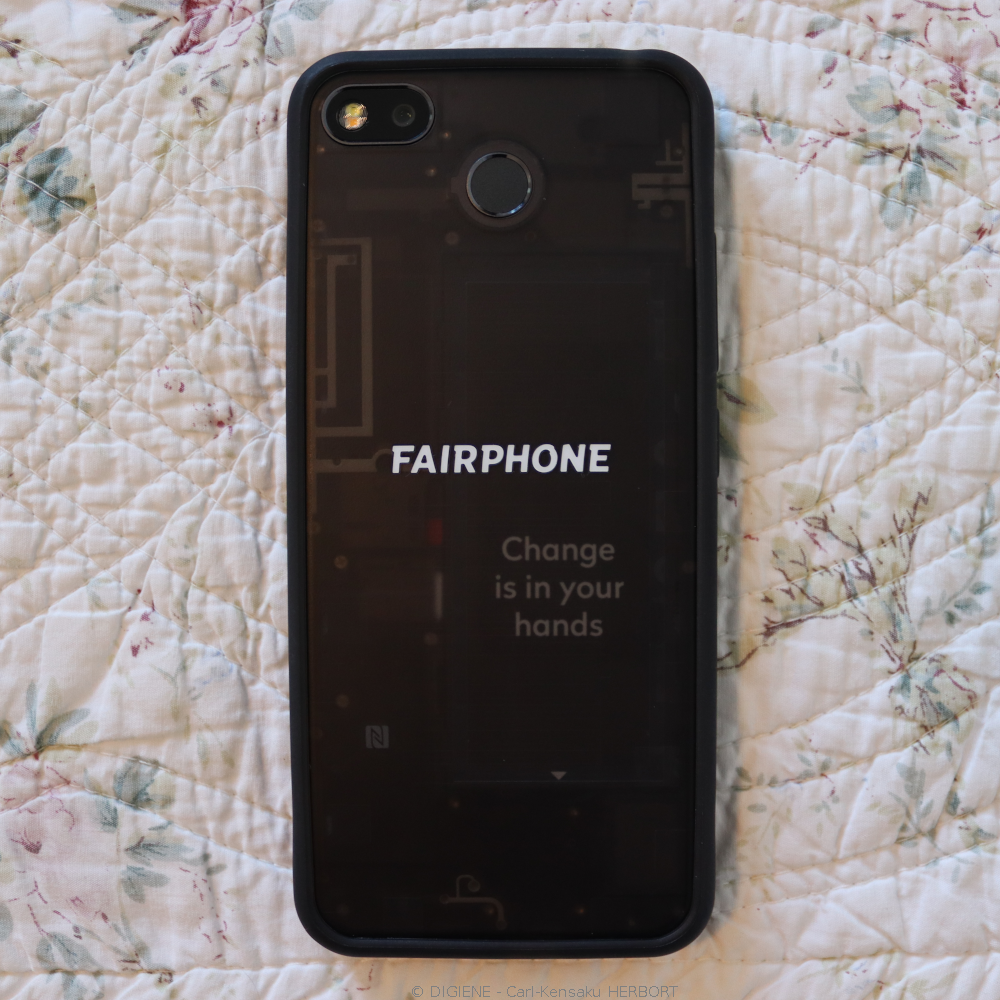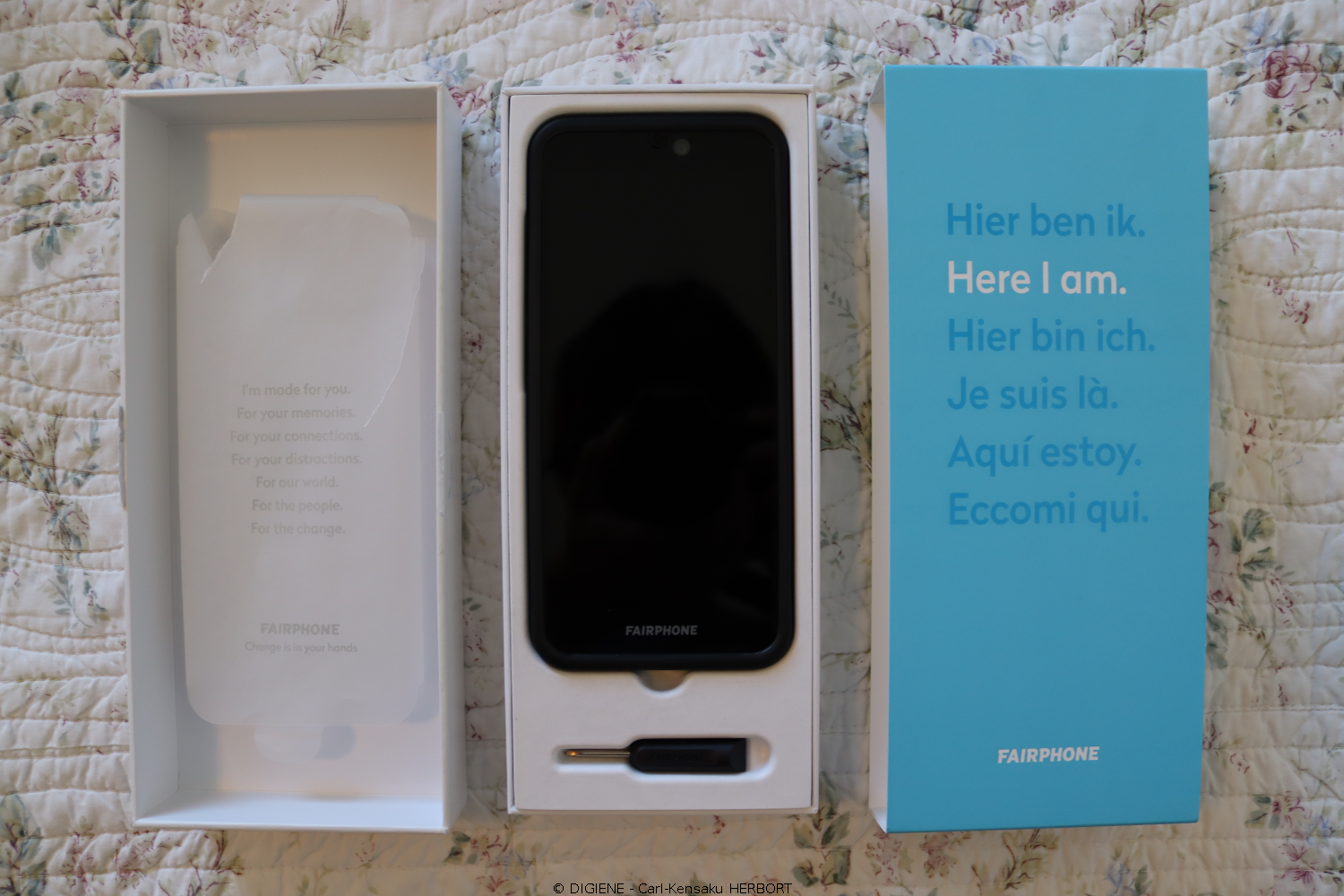Fairphone is a pioneer company of the Netherlands who aims to produce eco-friendly and socially responsible smartphones. The project started in 2010 and the company was created in 2013. DIGIENE has tested the Fairphone 3 for several months in real conditions. This review is based on this personal experience and on open-source information. This article applies to the Fairphone 3+ as well.
The Fairphone 3 has a global score of 4.6/10. It beats by far the competition on the fairness and ecology themes, even if there is a lot of room for improvement. But its strong point is the overall cost, mainly thanks to an excellent repairability and a long-life software. Its weak points are the lack of ruggedness (water, dust, etc) and privacy protection.
It is good for a personal use. A professional use is not recommended for now because of software developpement issues, low quality of support services and limited ruggedness. But Fairphone has proven to be a very innovative and dynamic company despite having relatively limited ressources. Therefore, one can expect an improvement in the future.
In general, information on the Fairphone 3 are easy to find on the official website and the rest of the web. But certain themes lack transparency: fairness of components (screws, connectors, LED), fairness of parts (screen, camera, loudspeaker), ruggedness, protection of privacy and animal welfare. No public information was available on a minority of sub-themes which got 0 points as a result. Fairphone often relies on external evaluations (laboratory, NGO, etc), which reinforces its credibility and the reliability of everything the company publishes.
1. Functionality (7/10)
1.1 Ergonomics

The three buttons on the left edge and the rear camera on the upper left corner make it easy to use with the right hand. With the left hand, there is sometimes a risk of blocking the rear camera with the index or accidentally activating the buttons. Fairphone could have at least placed the rear camera on the central axis, like the fingerprint reader. In contrast, the front camera is well situated in the center.
The power and data port in the middle of the lower edge is a very convenient USB-C: its symetrical form allows a successful connection everytime. The 3.5 mm jack on the upper edge allows to connect headphones or a handsfree kit without blocking the USB-C port. Additionally, this allows the Fairphone 3 to stay compatible with analog audio accessories without the need of an adaptor.
The hard internal case is well designed and elegant. On the other hand, the outer soft case (sold separately) has issues of expansion along the length as time goes by. The smartphone ends up getting out of its protective case too easily and dangerously. Furthermore, the holes for the camera and the fingerprint reader are shifting up: it is not very unaesthetic but the the camera and the fingerprint reader are still usable, for now. The touch screen is good enough for a standard use in terms of resolution, brightness and reactivity.
1.2 Configuration
The Fairphone 3 uses a pretty standard version of the Android operating system that includes Google Mobile Services (GMS). The configuration is therefore simple and quick. Otherwise, the system is light, doesn’t contain useless software (bloatware) and has the Google app store (Google Play). But, posessing or creating a Google account is necessary to access all services, such as Google Play for example.
1.3 Basic functions
The cellular modem is compatible up to the 4G/LTE norm whose speed is more than enough for most uses. But in the middle of a phone call, the Fairphone 3 can hang up and reboot without notice. This problem seems to have disappeared with the latest updates. But even corrected, a defect that serious on the basic phone function doesn’t inspire confidence in the reliability of the product in general. The Fairphone 3 is hence not recommended for an important use (professional use for example).
Sending and receiving SMS/MMS and chat apps (Whatsapp, Signal, etc) work well. The size of the internal storage is 64 GB: that’s small but it is possible to increase it with an external microSD card if necessary. The Wi-Fi, the Bluetoth and the geolocation (GPS, GLONASS, Galileo) fulfil their respectives roles, nothing more, nothing less.
1.4 Intermediate functions
In web browsing, the Fairphone 3 can reboot without notice, even on simple and light web pages. Apparently, the problem has disappeared, probably thanks to the latest updates. Even so, a defect that serious on the intermediate function of web browsing casts doubt on the ability of this smartphone to serve for an important use (professional use for example). As for the music, the loudspeaker has a standard quality for an integrated loudspeaker: without surprise, audiophiles will need headphones (AIAIAI TMA-2 for example) or an external loudspeaker (UE Boom for example).




The rear camera of the latest version (Fairphone 3+) has 48 megapixels, which is average too, but will not be sufficient for a demanding amateur photographer. It is still an improvement over the Fairphone 3 which only had 12 megapixels. The Fairphone 3 and the Fairphone 3+ were compared to the Canon EOS 250D, a low-range reflex camera. All three were left in the default configuration: the purpose is to compare, not to take the most beautiful pictures.
During the day, the Canon EOS 250D wins with more natural colors and a better resolution, followed by the Fairphone 3+ and then the Fairphone 3. This can be seen better when zooming in the picture. On the landscape photo, you can see it on the building on the left. In lowlight conditions, the ranking is the same: the reflex camera manages to capture a better picture that both the Fairphone 3+ and the Fairphone 3.



1.5 Advanced functions
Recording of videos is good enough for most uses but will not satisfy an enthusiast. Video on demand apps (Netflix, Disney+, Amazon Prime) work well. After a year of intensive use, the battery was still capable to stream episodes of a series on Netflix for 6h05 at maximum brightness on the cellular network (Wi-Fi, Bluetooth and geolocation turned off). Games run reasonably well, wether they are 3D (Asphalt 9 for example) or augmented reality (Pokémon GO for example).
2. Ruggedness (2/10)
2.1 Dust
The Fairphone 3 is not dustproof. It is a big flaw when compared to popular competing smartphones, all IP6X certified (more precisely IP68): the Apple IPhone 12, the Samsung Galaxy S21 or the Sony Xperia 10 III. Nowadays, it is a minimum standard for an object that one takes everywhere, including where there is dust: pocket, bag, park bench, etc.
2.2 Water
It is not waterproof to freshwater or seawater either. Again, this is a major weakness compared to competitors who all sell IPX8 certified mainstream mobile phones (more precisely IP68) against freshwater: the Apple IPhone 12, the Samsung Galaxy S21 or the Sony Xperia 10 III. Special rugged smarphones go even further: the Sonim XP8 has a IP68 and IP69 certification.
2.3 Shock and vibration
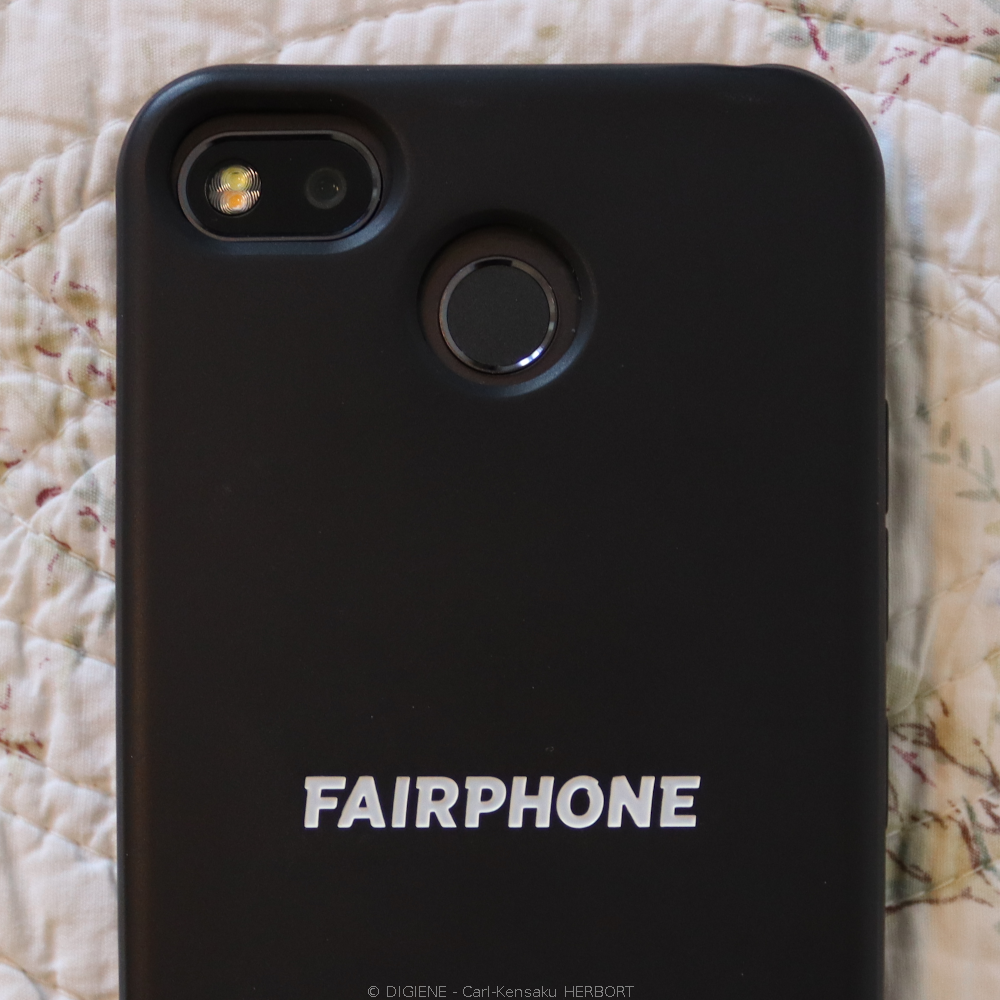
The outer soft case (sold separately) offers some shock protection, but without any guarantee or certification. Worse, it has dilation problems lengthwise with time. The smartphone ends up getting out of it too easily and dangerously.
There is no information on vibrations resistance. A mobile phone is used for many tasks on the go (communication, geolocation, instant translation, etc). It is also constantly exposed to shock and vibrations risks. It can fall while walking, from the pocket or off the edge of the desk. It is exposed to vibrations on the train tray table or when mounted in the car or on the bike handlebars. And yet, norms like the MIL-STD-810 standard have been around for a while as well as rugged phones that meet these standards such as the Crosscall CORE-X4.
2.4 Temperature
The Fairphone 3 is supposed to be used at a temperature between -10 degrees to 55 degrees, specifications that are not very different from the high-end rugged smartphone Cat S62 Pro. On the other hand, the resistance of the fair smartphone at brutal changes in temperature is not specified, which is a shame. Big and quick temperature changes are part of the daily life of a smartphone with the increasing popularity of air conditionning and heating.
2.5 Electromagnetism
There is no information on the protection of the Fairphone 3 (and its memory) against electromagnetism, unlike equipments such as the Samsung Bar Plus flash drive which is tested to resist magnetic fields or X-Rays of an airport machine for example. As phones contain a lot of important data, the memory of the Fairphone 3 should be protected.
3. Cost (7/10)
3.1 Price
The latest version is the Fairphone 3+. It costs around CHF 439.- (or 439 Euro). It is sold directly on the Fairphone website or through retailers (Digitec, Microspot, MediaMarkt, etc). If we only consider the price, the Fairphone 3+ is mid-range smartphone more expensive with lower specifications than its competitors, such as the Samsung A52 which can be found for less than CHF 350.-.
3.2 Lifespan
The Fairphone 3 is designed to last 5 years at least. The Fairphone company has proven itself with the exceptional lifespan of the Fairphone 2: spare parts, new camera and Android system still updated this year without the help of the chip maker. So it is probable that the Fairphone 3 will exceed 5 years.
3.3 Warranty
The two year warranty of the Fairphone 3 is nothing special in Switzerland. It is a disappointing short period for a product designed from the start to last. Moreover, “The Fairphone Warranty does not cover damage resulting from […] service performed by anyone who is not a Fairphone representative or an authorized Fairphone service provider“. Even if caution from Fairphone is understandable, this exclusion is far too vague and large for a repairable phone sold with a screwdriver (included in the package) to the general public.
3.4 Support
The Fairphone support service doesn’t read e-mails properly, doesn’t always answer to the questions, or sometimes doesn’t answer at all. One has to insist and insist. The Fairphone 3 is not recommended for an important use (professional use for example) as long as the suport service has not improved.
3.5 Repairability
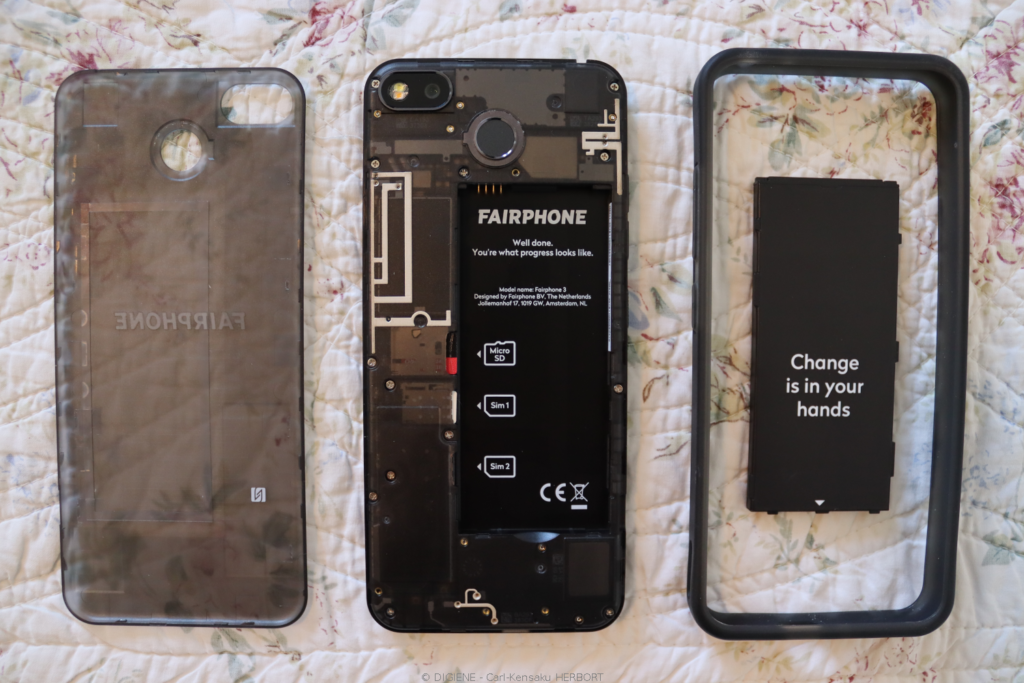
The repairability of the Fairphone 3 is impressive. It is largely due to the modularity of this smartphone. Almost all the parts can be replaced and bought separately: screen, case, battery, rear camera, front camera, loudspeaker, bottom module (microphone, USB-C connector, vibration motor). Finally, the assembly and disassembly is easy: some parts can be taken out without tools (case, battery) and the others only need a screwdriver. The Fairphone 3 is rated 10/10 by iFixit and gets a repairability score of 8.7/10 in France.
4. Fairness (3/10)
4.1 Raw material
7 raw materials come from fair or recycled sources on a average total of 40 contained in a smartphone. A new plan aims at reaching 14 raw materials. Furthermore, ores (like tin) are sourced from mines that don’t finance armed conflicts (conflict-free). Fairphone is a pioneer in this area, even if the Fairphone 3 is not produced entirely from fair materials.
4.2 Components and parts
Between raw materials and final assembly, there are two intermediate steps in the manufacturing chain: the components (screw, connectors, LED, etc) and parts (screen, camera, loudspeaker, etc). There is no information on the fairness of these two steps: salaries, working conditions, etc. Fairphone will need to bridge this gap in the coming years.
4.3 Assembly and packaging
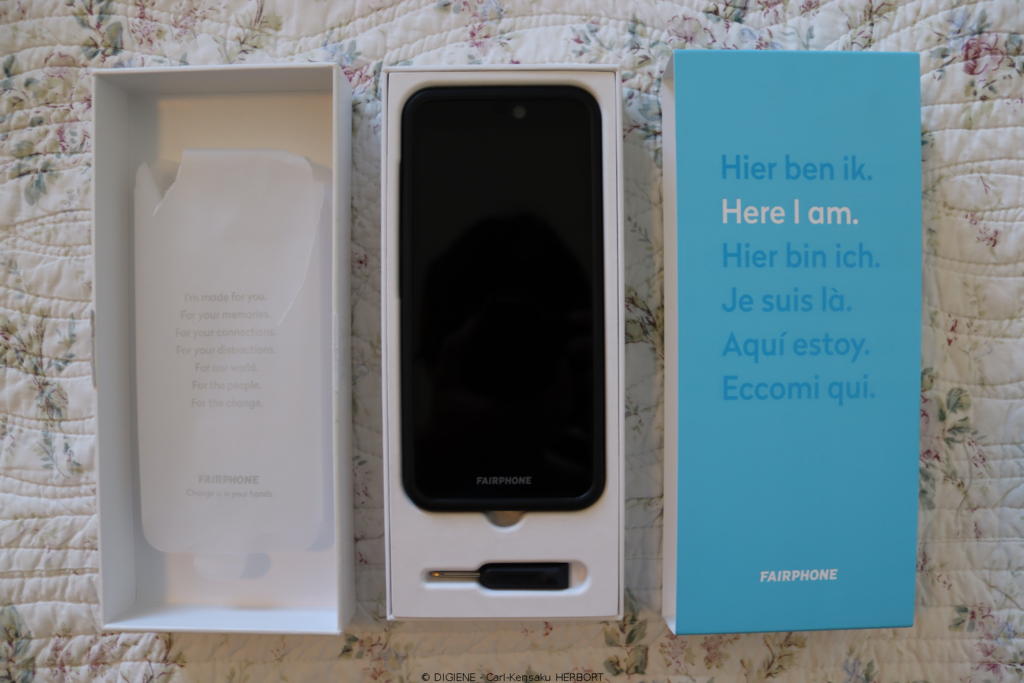
This is the other cutting edge field of Fairphone which is unsparing in its efforts. For the assembly and packaging, Fairphone has partnered with the Arima company based in Taiwan and whose factory is in Suzhou (China). The workers receive a 30% bonus for an additional cost of less than 2 Euros per smartphone. The salary thus covers the living wage. Employees participate in the improvement of their workplace better by giving their opinion. This participation has lead to funding for training opportunities and better canteen and dormitories.
4.4 Animal welfare
There is nothing on animal welfare or animal rights. Therefore, the Fairphone is not a cruelty-free certified product: a notion still too centered mainly on cosmetics. In general, it is a pity that the interpretation of fairness is often limited to human beings in the manufacturing chain.
4.5 Privacy protection and data protection
From a hardware point of view, the Fairphone 3 has no physical switches that allows to cut the power to the microphone, the camera, the radio connections (Wi-Fi, Bluetooth) and the 4G/LTE cellular modem. It doesn’t even have a webcam shutter. The hardware design of the Fairphone 3 doesn’t protect privacy, unlike its competitor, the Librem 5 manufactured by Purism.
From a software point of view, the Fairphone 3 is sold with the Android operating system with Google Mobile Services (GMS) preinstalled. Admittedly, there is no useless software (bloatware) which could collect additional personal data. But in contrast with the predecessor of the Fairphone 3, the manufacturer doesn’t provide an alternate free and open-source (FOSS) system. It recommends the e.Foundation which develops the /e/ OS, compatible with the Fairphone 3. Again, the Fairphone 3 pales into insignificance beside Purism which ships the Librem 5 with its free and open-source (FOSS) system PureOS, very respectful of privacy rights. Data protection and privacy protection is not the priority of the Fairphone 3.
5. Ecology and circular economy (4/10)
5.1 Climate
It is estimated that the impact of a Fairphone 3 during 7 years of use is about 8 kg of CO2. The carbon footprint reduction is amplified by the long lifespan of Fairphone products thanks to its repairability and an operating system kept up to date. In its last “Guide to Greener Electronics” Greenpeace report of 2017, Fairphone receives the B grade and outdoing the rest of the industry. The 2021 EcoVadis platinum medal confirms that. These results are admirable considering the limited means of Fairphone compared to the giants of the sector. But carbon neutrality is not yet achieved.
5.2 Biodiversity
For now Fairphone has managed to collect for recycling or reuse an electronic waste mass equivalent to 18% of the phones sold by the company (2020). It aims at 100% in the coming years. In addition, the manufacturer has determined that the maximum recycling rate of a Fairphone is 45.1% with current technology and in the best conditions. It concludes that for now, mining has to continue in combination with recycling. Efforts of Fairphone in this field is impressive, even more considering the small size of the company compared to the other electronic manufacturers. However, all this is still far from being a circular economy. Therefore, the Fairphone 3 is not Cradle to Cradle certified.
